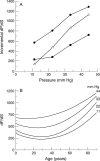Age related compliance of the lamina cribrosa in human eyes
- PMID: 10684845
- PMCID: PMC1723411
- DOI: 10.1136/bjo.84.3.318
Age related compliance of the lamina cribrosa in human eyes
Abstract
Aims: To investigate changes in the mechanical compliance of ex vivo human lamina cribrosa with age.
Methods: A laser scanning confocal microscope was used to image the surface of the fluorescently labelled lamina cribrosa in cadaver eyes. A method was developed to determine changes in the volume and strain of the lamina cribrosa created by increases in pressure. The ability of the lamina cribrosa to reverse its deformation on removal of pressure was also measured.
Results: Volume and strain measurements both demonstrated that the lamina cribrosa increased in stiffness with age and the level of pressure applied. The ability of the lamina cribrosa to regain its original shape and size on removal of pressure appeared to decrease with age, demonstrating an age related decrease in resilience of the lamina cribrosa.
Conclusions: The mechanical compliance of the human lamina cribrosa decreased with age. Misalignment of compliant cribriform plates in a young eye may exert a lesser stress on nerve axons, than that exerted by the rigid plates of an elderly lamina cribrosa. The resilience of the lamina cribrosa also decreased with age, suggesting an increased susceptibility to plastic flow and permanent deformation. Such changes may be of importance in the explanation of age related optic neuropathy in primary open angle glaucoma.
Figures







References
Publication types
MeSH terms
LinkOut - more resources
Full Text Sources
Medical
